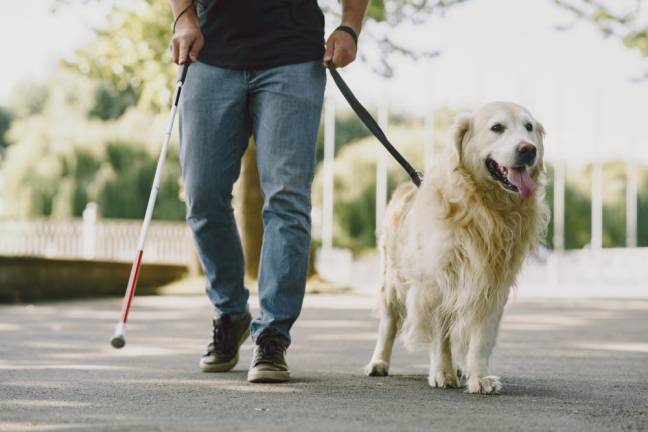Faithful Friends
New rules for service and companion animals

When is Fido more than a friend?
According to the Federal Americans with Disabilities Act (ADA), when he’s working to “perform tasks for the benefit of an individual with a disability that limits such ordinary tasks as seeing, hearing, standing, walking, eating, thinking, and sleeping.”
That’s a job with a long and honorable history tracking all the way back to ancient times via a Pompeian painting showing a blind beggar being led by an early seeing-eye dog. Fast forward a millennia or two and there are similar European wood carvings and Chinese scroll paintings of dogs leading people.
The first American service dog appears to have been Buddy, a Swiss German Shepard who landed here in 1928 with a blind man named Morris Frank, whose experience led him one year later to found The Seeing Eye, America’s oldest guide dog school.
Today, an estimated more than 500,000 service dogs get up each morning ready for their first walk, their first meal, and their first move to help their masters make it more easily through the day. The Feds rank our furry friends according to their ability and training. Service animals head the list, followed by emotional support animals, and last but hardly least, companion animals like Fluffy, the cat who is sitting on your keyboard as you read this. ADA codifies the rules for where each may go, but states may broaden the list.
“Under Control”
In New York, service dogs (or miniature horses, no kidding) are granted entry nearly any place you are. That includes public housing, private housing (if the renter is disabled), public and private transportation, schools and educational institutions, theaters and museums, restaurants, and the whole wide range of shops. The only caution is that the dog must be “under control.” A harness, a leash or strong voice command works, but if a service animal growls, barks, assumes an aggressive stance, out he (or she) goes.
Once qualified by a health care provider who confirms in writing the patient’s disability and need for assistance, any New Yorker can apply for a service animal. With paper in hand, the next step is to reach out to one of the state and local groups that provide service dogs.
As for Fluffy, the companion cat sitting on your computer keyboard as you type, no problem: She’s not a service animal but she matters. In fact, she matters so much that last June, by a vote of 61-0 in the State Senate and 149-0 in the State Assembly, the legislature passed the Companion Animal Care Standards Act for Shelters and Rescues. The bill raises the standards of care including but not limited to physical space, behavior, transport, record keeping and veterinary care for both shelters and rescues.
As Assembly member Linda Rosenthal, a staunch advocate who has authored more than 20 animal-protective laws neatly puts it, “Animals enrich our lives in so many ways, and for people with disabilities, the support and comfort that a service animal can provide allows them to expand their horizons and lead a better life. With each animal protection law passed, we are giving a voice to the voiceless and chipping away at the notion that animals are merely property. Anyone who has had a pet or has been helped by a service animal can attest that animals are sentient beings worthy of our protection and love.”
Woof. Neigh. And don’t forget meow.